| |
|
|
|
Historical > Historical Xerox
Cutter 1 | 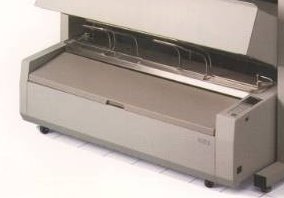 | The Xerox Cutter 1 was developed initially as a stand alone, roll to sheet cutter, sold in tandem with the 2510 and called the 2510 Engineering System. The Cutter 1 is designed to cut sheets from a roll of media. It is programmable for pre-set and special sizes. With the introduction of the 2520, as an option, the Cutter 1 could be interfaced with the 2520 so that the Cutter 1 could cut sheets of appropriate size paper for the document being copied in the 2520. Another attempt at product enhancement of the 2520 by Xerox. |
| [−] |
| Roll Size |
Accepts single rolls in 16.45"
to 36". Widths
in standard inch and metric sizes; nominal roll lengths 500' or
6.75" in diameter. |
| Standard Output Sizes |
B-E sheets (in 11" by 17":
and 12" by 18" (multiples); A3-A0 (in standard metric sizes).
Manual selection of sheet lengths
from 10.0" to
409.9" to the nearest tenth of an inch. |
| Output Media |
Engineering/drafting media
including: parer (bond or diazo) and vellum to 24 lb. weights; drafting
film to 4 mil thick. |
| Output Quanity |
Select 1-99 sheets. |
| Power consumption |
345 watts at 115 volts |
| Dimensions |
12.25" high, 47" wide, 16
deep. |
| Price Range at Introduction |
about $2,700 |
| Weight |
115 Lbs. |
|
Xerox 2080 | 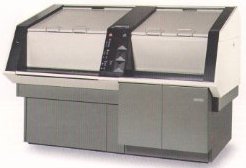 | The 2080 is the oldest of the Xerox professional grade, analog engineering copiers still in service. In the US, 2080's have by and large been replaced by the 5080. Because of its simplicity and ease of repair, the 2080 remains a popular machine in third world countries where parts availability and continuous supplies of "clean" electricity are a problem. The 2080 can be repaired in the field by technicians without extensive, high level training. 2080's will accept documents up to 36 inches wide and output copies up to 24 inches wide. The original must be hand fed for each copy desired, which makes production of multiple copies a problem. This can be overcome in sets work by "stream feeding" a set of originals. The 2080, due to its ability to copy continuously, is a natural for strip records such as oil well logs. Simplicity and rugged construction are pluses. Inability to produce multiple copies and to output 36 inches wide are the down sides. |
| [−] |
| Maximum Input Width |
36" |
|
Exposure Control |
Yes |
| Maximum Input Length |
Unlimited |
|
Reproduction Quality
of Solids |
Good |
| Maximum Output Width |
24" |
|
Reproduction Quality
of Linework |
Excellent |
| Maximum Output Length |
Unlimited |
|
Reproductions of Halftones |
Fair |
| Multiple Copies |
No |
|
Feet Per Minute |
20 |
| Reduction Capability |
Yes |
|
Copies Per Minute |
7D Size |
| Enlargement Capability |
Yes |
|
Collating Capability |
None |
| Zoom Lens |
Yes |
|
Analog or Digital Technology |
Analog |
| Accuracy |
+or- .5% |
|
Photoreceptor Type |
Selenium |
| Thick or Solid Originals |
Yes |
|
Toning System |
Dual Component |
| Auto or Manual Roll Feed |
Auto |
|
Other Features |
N/A |
| Auto or Manual Sheet
Feed |
None |
|
Price Range at Introduction |
$60,000 |
| Manual Paper By-Pass |
Yes |
|
Equipment Manufactured
By |
Xerox |
| Number of Rolls |
2 |
|
Footprint and Height |
55" x 91" x 63" |
| Maximum Cassette Size |
N/A |
|
Weight |
2425 |
| Light-Dark Document Control |
No |
|
AC Power Requirements |
220V - 40A |
|
Xerox 2510 | 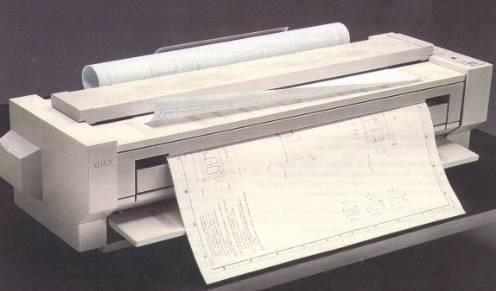 | The Xerox 2510 was the first "point of use" engineering copier available in the thirty-six inch width. It is a low volume machine designed for environments requiring fewer than one thousand linear feet of copy per month. Its principal shortcoming is that when multiple copies of originals less than thirty-six inches wide are made, toner is depleted from the developer in that particular area of the developer housing. This can result in a light band in wider document copies that may follow. This phenomena is overcome by cycling the machine several times thus introducing new toner into the developer housing. More 2510's have been manufactured and sold by Xerox than any other engineering copier ever manufactured. |
| [−] |
| Maximum Input Length |
Unlimited |
|
Reproduction Quality of Solids |
Fair |
| Maximum Output Width |
36" |
|
Reproduction Quality of Linework |
Good |
| Maximum Output Length |
Unlimited |
|
Reproductions of Halftones |
Poor |
| Multiple Copies |
No |
|
Feet Per Minute |
10 |
| Reduction Capability |
None |
|
Copies Per Minute |
3 D Size |
| Enlargement Capability |
None |
|
Collating Capability |
None |
| Zoom Lens |
No |
|
Photoreceptor Type |
Selenium |
| Accuracy |
+or- .5% |
|
Toning System |
T&D |
| Thick or Solid Originals |
Yes |
|
Other Features |
N/A |
| Auto or Manual Roll Feed |
None |
|
Price Range at Introduction |
$5000 |
| Auto or Manual Sheet Feed |
Manual |
|
Equipment Manufactured By |
Xerox |
| Manual Paper By-Pass |
No |
|
Footprint and Height |
55" x 20" x 16" |
| Number of Rolls |
None |
|
Weight |
175 |
| Maximum Cassette Size |
N/A |
|
AC Power Requirements |
115V - 15A |
| Light-Dark Document Control |
Yes |
|
|
|
|
Xerox 2515 | 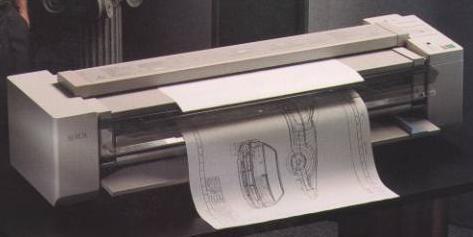 | The 2515 is an upgrade of the 2510. Xerox incorporated a recalculating developer housing which leveled toner concentrations and eliminated the "banding" caused by toner depletion in the 2510. Cosmetic changes to the end caps and paper feed shelf differentiate the 2510 and the 2515. |
| [−] |
| Maximum Input Width |
36" |
|
Exposure Control |
Yes |
| Maximum Input Length |
20' |
|
Reproduction Quality of Solids |
Fair |
| Maximum Output Width |
36" |
|
Reproduction Quality of Linework |
Good |
| Maximum Output Length |
20' |
|
Reproductions of Halftones |
Poor |
| Multiple Copies |
No |
|
Feet Per Minute |
10 |
| Reduction Capability |
None |
|
Copies Per Minute |
3 D Size |
| Enlargement Capability |
None |
|
Collating Capability |
None |
| Zoom Lens |
No |
|
Photoreceptor Type |
Selenium |
| Accuracy |
+or- .5% |
|
Toning System |
Toner & Developer |
| Thick or Solid Originals |
Yes |
|
Other Features |
Partial Copy |
| Auto or Manual Roll Feed |
None |
|
Price Range at Introduction |
$5000 |
| Auto or Manual Sheet Feed |
Manual |
|
Equipment Manufactured By |
Xerox |
| Manual Paper By-Pass |
No |
|
Footprint and Height |
55" x 20" x 14" |
| Number of Rolls |
None |
|
Weight |
180 |
| Maximum Cassette Size |
N/A |
|
AC Power Requirements |
115V - 15A |
| Light-Dark Document Control |
Yes |
|
|
|
|
Xerox 2520 | 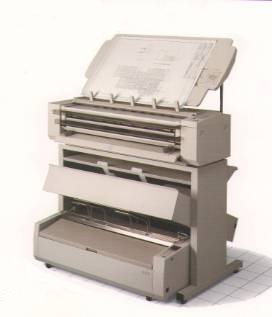 | The 2520 was a marginally successful attempt by Xerox to add a list of sophisticated "features" to the 2510 mainframe in order to provide an upward product migration path for the 25XX family. They were successful in introducing a recirculation developer housing which eliminated the banding of prints caused by toner depletion. The addition of a recirculation document handler eliminated the need to re-feed the original for each copy being made. Additional features such as "sets", "binding edge control" and "partial copy" proved to be of limited value. The 2520 incorporated circuitry that permitted the addition of an Automatic Sheet Feeder and an automatic sheet cutter known as the Cutter 1. |
| [−] |
| Maximum Input Width |
36" |
|
Exposure Control |
Yes |
| Maximum Input Length |
Unlimited |
|
Reproduction Quality
of Solids |
Fair |
| Maximum Output Width |
36" |
|
Reproduction Quality
of Linework |
Poor |
| Maximum Output Length |
Unlimited |
|
Reproduction of Halftones |
Fair |
| Multiple Copies |
Yes |
|
Feet Per Minute |
12 |
| Reduction Capability |
None |
|
Copies Per Minute |
4 D Size |
| Enlargement Capability |
None |
|
Collating Capability |
None |
| Zoom Lens |
No |
|
Photoreceptor Type |
Selenium |
| Accuracy |
+or- .5% |
|
Toning System |
Toner & Developer |
| Thick or Solid Originals |
Yes |
|
Other Features |
Partial Copy |
| Auto or Manual Roll Feed |
None |
|
Price Range at Introduction |
$9000 |
| Auto or Manual Sheet
Feed |
Manual |
|
Equipment Manufactured
By |
Xerox |
| Manual Paper By-Pass |
No |
|
Footprint and Height |
56" x 24" x 65" |
| Number of Rolls |
None |
|
Weigh |
363 |
| Maximum Cassette Size |
N/A |
|
AC Power Requirements |
120V- 20A |
| Light-Dark Document Control |
Yes |
|
|
|
|
Xerox 2520A | 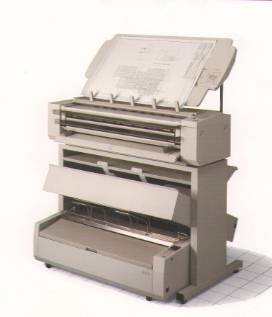 | The 2520A incorporated a standard Xerox 2520 and Cutter 1 configuration with a customized stand manufactured by Neolt of Italy. The customized Neolt stand included a baffling system which automatically fed sheets of paper from the Cutter 1 to the 2520 allowing the 2520A to make up to nine copies automatically in unattended mode. The system proved to be effective but required constant adjustment. |
| [−] |
| Maximum Input Width |
36" |
|
Exposure Control |
Yes |
| Maximum Input Length |
Unlimited |
|
Reproduction Quality
of Solids |
Fair |
| Maximum Output Width |
36" |
|
Reproduction Quality
of Linework |
Good |
| Maximum Output Length |
Unlimited |
|
Reproductions of Halftones |
Poor |
| Multiple Copies |
Yes |
|
Feet Per Minute |
12 |
| Reduction Capability |
None |
|
Copies Per Minute |
4 D Size |
| Enlargement Capability |
None |
|
Collating Capability |
None |
| Zoom Lens |
No |
|
Photoreceptor Type |
Selenium |
| Accuracy |
+or- .5% |
|
Toning System |
Toner & Developer |
| Thick or Solid Originals |
Yes |
|
Other Features |
Partial Copy |
| Auto or Manual Roll Feed |
Auto |
|
Price Range at Introduction |
$13,000 |
| Auto or Manual Sheet
Feed |
Manual |
|
Equipment Manufactured
By |
Xerox |
| Manual Paper By-Pass |
No |
|
Footprint and Height |
56" x 32" x 65" |
| Number of Rolls |
None |
|
Weight |
363 |
| Maximum Cassette Size |
N/A |
|
AC Power Requirements |
115V - 15A |
| Light-Dark Document Control |
Yes |
|
|
|
|
Xerox 2520ASF |  | The Xerox 2520ASF married the standard 2520 with a field installable ASF (Automatic Sheet Feed) kit. The addition of the ASF allowed the 2520 to automatically feed copy paper up to "D" size into the copier. This system was another attempt by Xerox to expand the capability of the 2520. It was marginally successful as the ASF adaptation tended to be difficult to keep in adjustment, particularly in humid climate's where moisture in the paper became a factor in getting the copy paper to feed properly. |
| [−] |
| Maximum Input Width |
36" |
|
Exposure Control |
Yes |
| Maximum Input Length |
Unlimited |
|
Reproduction Quality
of Solids |
Fair |
| Maximum Output Width |
36" |
|
Reproduction Quality
of Linework |
Good |
| Maximum Output Length |
Unlimited |
|
Reproductions of Halftones |
Poor |
| Multiple Copies |
Yes |
|
Feet Per Minute |
12 |
| Reduction Capability |
None |
|
Copies Per Minute |
4 D Size |
| Enlargement Capability |
None |
|
Collating Capability |
None |
| Zoom Lens |
No |
|
Photoreceptor Type |
Selenium |
| Accuracy |
+or- .5% |
|
Toning System |
Toner & Developer |
| Thick or Solid Originals |
Yes |
|
Other Features |
Partial Copy |
| Auto or Manual Roll Feed |
None |
|
Price Range at Introduction |
$12,000 |
| Auto or Manual Sheet
Feed |
Automatic |
|
Equipment Manufactured
By |
Xerox |
| Manual Paper By-Pass |
Yes |
|
Footprint and Height |
56" x 32" x 67" |
| Number of Rolls |
None |
|
Weight |
478 |
| Maximum Cassette Size |
24"X36" |
|
AC Power Requirements |
115V 15A |
| Light-Dark Document Control |
Yes |
|
|
|
|
Xerox 3001 | 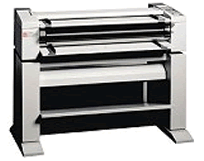 | The low end of the Xerox spectrum. The 3001 was designed to enter the market at under $5,000 and function as an upgraded 2510. They have added the automatic document handler from the old 2520 which keeps the operator from having to feed the original each time, but it is sheet feed and the operator must insert the blank paper for each copy. This is a labor intensive machine whose operational ceiling is 500 "D" size prints per month. |
| [−] |
|
Maximum Input Width
|
36"
|
Exposure Control
|
Yes
|
|
Maximum Input Length
|
20'
|
Reproduction Quality of Solids
|
Fair
|
|
Maximum Output Width
|
36"
|
Reproduction Quality of Linework
|
Excellent
|
|
Maximum Output Length
|
20'
|
Reproduction of Halftones
|
Poor
|
|
Multiple Copies
|
No
|
Feet Per Minute
|
10
|
|
Reduction Capability
|
None
|
Copies Per Minute
|
3 D Size
|
|
Enlargement Capability
|
None
|
Collating Capability
|
None
|
|
Zoom Lens
|
No
|
Photoreceptor Type
|
Selenium
|
|
Accuracy
|
+or- .5%
|
Toning system
|
Toner & Developer
|
|
Thick or Solid Originals
|
Yes, 1/8"
|
Optional Accessories
|
Auditron
|
|
Sheet Feed
|
Yes
|
Price Range at Introduction
|
$5,570
|
|
Automatic Document Handler
|
10 Cycles
|
Equipment Manufactured By
|
Xerox
|
|
Light-Dark Document Control
|
Yes
|
Footprint and Height
|
55"x19"x42"
|
|
|
|
Power Requirement
|
115 V, 20A
|
|
Xerox 3060 | 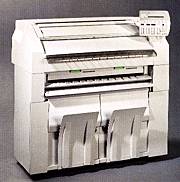 | Based on their highly successful mid-range flag ship, the 3050, Xerox tried to build an analog reduction and enlargement machine by adding a set of 5080 optics. While this proved to be a significant engineering achievement, the resulting product does not measure up to the 3050 in quality. Xerox simply cut too many corners with this machine. This fact is demonstrated in the high rate of service required to keep it operational. The other problem with the 3060 is not mechanics but sales. Xerox sales reps invariably market the 3060 as a mini 5080, capable of high volume, high speed, reduction and enlargement production work. It is not a production machine. It is a mid-volume, analog, convenience copier, with a very poor track record. The 3060 has been end of lifed and its market slot taken over by low priced digital machines. |
| [−] |
| Maximum Input Width |
36" |
|
Exposure Control |
Yes |
| Maximum Input Length |
20' |
|
Reproduction Quality
of Solids |
Fair |
| Maximum Output Width |
36" |
|
Reproduction Quality
of Linework |
Excelent |
| Maximum Output Length |
20' |
|
Reproductions of Halftones |
Poor |
| Multiple Copies |
Yes |
|
Feet Per Minute |
12 |
| Reduction Capability |
Yes |
|
Copies Per Minute |
6 D Size |
| Enlargement Capability |
Yes |
|
Collating Capability |
No |
| Zoom Lens |
Yes |
|
Photoreceptor Type |
Selenium |
| Accuracy |
+or- .5% |
|
Toning System |
Toner & Developer |
| Thick or Solid Originals |
Yes |
|
Other Features |
Auditron |
| Auto or Manual Roll Feed |
Auto |
|
Price Range AT Introduction |
$40,000 |
| Auto or Manual Sheet
Feed |
None |
|
Equipment Manufactured
By |
Xerox |
| Manual Paper By-Pass |
Yes |
|
Footprint and Height |
36" x 57" x 56" |
| Number of Rolls |
3 |
|
Weight |
1000 |
| Maximum Cassette Size |
N/A |
|
AC Power Requirements |
115V - 15A |
| Light-Dark Document Control |
Yes |
|
|
|
|
Xerox 3080 | 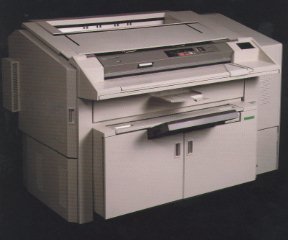 | The 3080, with its relatively "high speed" for the time, was originally billed by Xerox as the bond paper machine that was going to replace diazo. Things just did not work out that way. The 3080 used a strobe to fuse toner to the surface of the copy media. The idea had been tried before in letter-legal machines with marginal results. The problem was that the strobing action "reflected" and made it difficult to copy onto clear polyester film copy media. You can however, copy onto matte finish films and vellums. This brings us to the second problem. Because the 3080 uses toner that melts at very low temperatures due its strobe fusing system, translucent originals made on the machine tend to "offset" toner onto the glass drum of diazo printers. Also copies left on hot surfaces (such as the hood of a car on a hot day) for short periods of time tend to "offset" toner onto the preceding page. The bottom line is that the more feature rich 3090, which replaced the 3080, is |
| [−] |
| Maximum Input Width |
36" |
|
Exposure Control |
Both |
| Maximum Input Length |
Unlimited |
|
Reproduction Quality
of Solids |
Fair |
| Maximum Output Width |
36" |
|
Reproduction Quality
of Linework |
Excellent |
| Maximum Output Length |
Unlimited |
|
Reproductions of Halftones |
Fair |
| Multiple Copies |
Yes |
|
Feet Per Minute |
21 |
| Reduction Capability |
No |
|
Copies Per Minute |
8 D Size |
| Enlargement Capability |
No |
|
Collating Capability |
Yes |
| Zoom Lens |
No |
|
Analog or Digital Technology |
Analog |
| Accuracy |
+or- .5% |
|
Photoreceptor Type |
Selenium |
| Thick or Solid Originals |
.05mm |
|
Toning System |
Dual Component |
| Auto or Manual Roll Feed |
Auto |
|
Other Features |
Folder |
| Auto or Manual Sheet
Feed |
Yes |
|
Price Range at Introduction |
$62,000 |
| Manual Paper By-Pass |
Yes |
|
Equipment Manufactured
By |
Xerox |
| Number of Rolls |
2 |
|
Footprint and Height |
46" x 72" x 79" |
| Maximum Cassette Size |
18" X 24" |
|
Weight |
2100 |
| Light-Dark Document Control |
No |
|
AC Power Requirements |
220V - 50A |
|
Xerox 3090 | 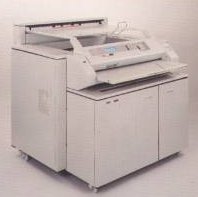 | With the 3090, Xerox once again announced they had brought to market the "bond paper copier that would replace diazo" and once again they were wrong. The 3090 is fundamentally a 3080 with a new radiant (toaster element type) fuser replacing the old flash fuser. With the fuser change, toner offsetting problems encountered with the 3080 were eliminated and the machine was speeded up to 30 feet per minute. Most of the 3090's were sold with what they called a "Flat Sheet Sorter 36", which is in reality a large flat sheet collator made by Norfin Corporation. The collator is the same one that is used by all of the manufacturers on their high speed analog gear. It is capable of handling sheets up to 36" x 48" in twenty bins of up to 50 sheets per bin. The resulting combination yields a product with which a single operator can produce large quantities of ready to be bound, bond paper print sets, without assistance. It is not uncommon for groups of 3090's to be run 24 hours a day for months at a time. The 3090 with Sorter 36 is the pinnacle of analog, bond paper sets production. |
| [−] |
| Maximum Input Width |
36" |
|
Exposure Control |
Both |
| Maximum Input Length |
Unlimited |
|
Reproduction Quality
of Solids |
Good |
| Maximum Output Width |
36" |
|
Reproduction Quality
of Linework |
Excellent |
| Maximum Output Length |
Unlimited |
|
Reproductions of Halftones |
Fair |
| Multiple Copies |
Yes |
|
Feet Per Minute |
30 |
| Reduction Capability |
None |
|
Copies Per Minute |
13 D Size |
| Enlargement Capability |
None |
|
Collating Capability |
Yes |
| Zoom Lens |
No |
|
Analog or Digital Technology |
Analog |
| Accuracy |
+or- .5% |
|
Photoreceptor Type |
Selenium |
| Thick or Solid Originals |
.22mm |
|
Toning System |
Dual Component |
| Auto or Manual Roll Feed |
Auto |
|
Other Features |
Folder |
| Auto or Manual Sheet
Feed |
Auto |
|
Price Range at Introduction |
? |
| Manual Paper By-Pass |
Yes |
|
Equipment Manufactured
By |
Xerox |
| Number of Rolls |
4 |
|
Footprint and Height |
58" x 60" x 57" |
| Maximum Cassette Size |
N/A |
|
Weight |
2005 |
| Light-Dark Document Control |
No |
|
AC Power Requirements |
220V - 50A |
|
Xerox 5080 |  | The 5080 was the evolutionary pinnacle of wide format, analog technology, and it quickly became the standard of the industry. With reduction and enlargement in one tenth of one percent increments, plus multiple copies and the option of flat sheet sorters and folders, made it state of the art for it's time. Introduction of digital wide format technology signaled the doom of the 5080. Xerox Engineering Systems insistence on relying on it's installed base of 5080's and refusing to adapt to the changing world of wide format digital cost them the their dominant market position in the industry. |
| [−] |
| Maximum Input Width |
36" |
|
Light-Dark Document Control |
Yes |
| Maximum Input Length |
Unlimited |
|
Exposure Control |
Yes |
| Maximum Output Width |
36" |
|
Reproduction Quality
of Solids |
Good |
| Maximum Output Length |
Unlimited |
|
Reproduction Quality
of Linework |
Excellent |
| Multiple Copies |
1-99 |
|
Reproductions of Halftones |
Fair |
| Reduction Capability |
Yes |
|
Feet Per Minute |
20 |
| Enlargement Capability |
Yes |
|
Copies Per Minute |
7 D Size |
| Zoom Lens |
45%-200% |
|
Collating Capability |
Yes |
| Accuracy |
+or- .5% |
|
Analog or Digital Technology |
Analog |
| Thick or Solid Originals |
2.5mm |
|
Photoreceptor Type |
Selenium |
| Auto or Manual Roll Feed |
Auto |
|
Toning System |
Dual Component |
| Auto or Manual Sheet
Feed |
None |
|
Other Features |
Folder |
| Manual Paper By-Pass |
Yes |
|
Price Range at Introduction |
$137,000 |
| Number of Rolls |
3 |
|
Equipment Manufactured
By |
Xerox |
| Maximum Cassette Size |
N/A |
|
Footprint and Height |
69" x 73" x 61" |
| Weight |
2688 |
|
AC Power Requirements |
220V - 50A |
|
Xerox 7080 | 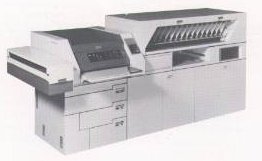 | The 7080 is a bit like the bumble bee. If you had not seen it fly, you would have said it never would. The unit was developed in Japan by Fuji Xerox under an agreement with Bell Telephone. The idea was to produce a bond paper copier that could reduce "D" and "E" size originals to "B" and "C" size for field distribution as folded, collated sets. Because the 7080 is sheet fed and must perform all manor of contortions to deliver a finish product, it is subject to jams and requires constant adjustment.
|
| [−] |
| Maximum Input Width |
36" |
|
Exposure Control |
Yes |
| Maximum Input Length |
48" |
|
Reproduction Quality
of Solids |
Good |
| Maximum Output Width |
18" |
|
Reproduction Quality
of Linework |
Excellent |
| Maximum Output Length |
24" |
|
Reproductions of Halftones |
Fair |
| Multiple Copies |
Yes |
|
Feet Per Minute |
N/A |
| Reduction Capability |
Yes |
|
Copies Per Minute |
24 C Size |
| Enlargement Capability |
No |
|
Collating Capability |
Yes |
| Zoom Lens |
Fixed Stop |
|
Analog or Digital Technology |
Analog |
| Accuracy |
+or- .5% |
|
Photoreceptor Type |
Selenium |
| Thick or Solid Originals |
- |
|
Toning System |
Dual Component |
| Auto or Manual Roll Feed |
None |
|
Other Features |
Folder |
| Auto or Manual Sheet
Feed |
Auto |
|
Price Range at Introduction |
$123,000 |
| Manual Paper By-Pass |
- |
|
Equipment Manufactured
By |
Xerox |
| Number of Rolls |
N/A |
|
Footprint and Height |
52" x 134" x 51" |
| Maximum Cassette Size |
18"X 24" |
|
Weight |
3139 |
| Light-Dark Document Control |
Yes |
|
AC Power Requirements |
220V - 40A |
|
Xerox 7085 | 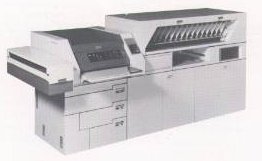 | The 7085 was an attempt to breathe new life into a product that was "running out of gas." They replaced the fuser station, a weak component of the old 7080, with a reworked system that was only marginally better. Cosmetic changes, the addition of a "couple of racing stripes", and a handful of "fairy dust" were supposed to make the 7085 a new product. It didn't work. |
| [−] |
| Maximum Input Width |
36" |
|
Exposure Control |
Yes |
| Maximum Input Length |
48" |
|
Reproduction Quality
of Solids |
Good |
| Maximum Output Width |
18" |
|
Reproduction Quality
of Linework |
Excellent |
| Maximum Output Length |
24" |
|
Reproductions of Halftones |
Fair |
| Multiple Copies |
Yes |
|
Feet Per Minute |
N/A |
| Reduction Capability |
Yes |
|
Copies Per Minute |
24 C Size |
| Enlargement Capability |
No |
|
Collating Capability |
Yes |
| Zoom Lens |
Fixed Stop |
|
Analog or Digital Technology |
Analog |
| Accuracy |
+or- .5% |
|
Photoreceptor Type |
Selenium |
| Thick or Solid Originals |
N/A |
|
Toning System |
Dual Component |
| Auto or Manual Roll Feed |
None |
|
Other Features |
Folder |
| Auto or Manual Sheet
Feed |
Auto |
|
Price Range at Introduction |
$123,000 |
| Manual Paper By-Pass |
N/A |
|
Equipment Manufactured
By |
Xerox |
| Number of Rolls |
N/A |
|
Footprint and Height |
52" x 134" x 51" |
| Maximum Cassette Size |
18"X 24" |
|
Weight |
3139 |
| Light-Dark Document Control |
Yes |
|
AC Power Requirements |
220V - 40A |
|
Xerox 8150 | 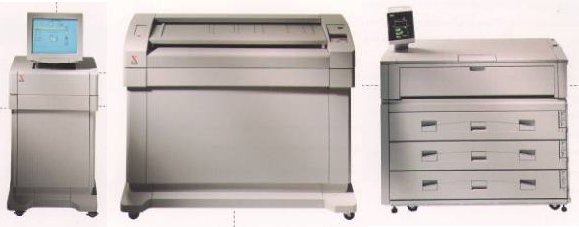 | A short term answer to the "lack of a digital product crisis" at XES. The 8150 is being replaced by the 8855. |
| [−] |
| Scan to Print |
Yes |
| Plot |
Yes |
| Scan to File |
Yes |
| Minimum Output |
8-1/2" X 11" |
| Maximum Output |
36" X 16' |
| Feet per Minute |
15 |
| Copies Per Minute |
7 "D" Size |
| Number of Rolls |
3 |
| Manual By-pass |
Yes |
| Multiple Copies |
1 - 99 |
| Zoom Capability |
25% to 400% |
| Accuracy |
+ or - .1% |
| Thick or Solid Originals |
? |
| Collating Capability |
Electronic |
| Photoreceptor Type |
Selenium |
| Toning System |
Toner & Developer |
| Reproduction Quality of Solids |
Good |
| Reproduction Quality of Line
Work |
Excellent |
| Reproduction of Halftones |
Fair |
| Other Features |
- |
Scanner
| Minimum Input |
8-1/2" X 11" |
| Maximum Input |
36" X 30' |
| Resolution |
400 dpi Maximum |
| Speed |
10 fpm at 400 dpi |
| Formats |
? |
Controller
| Technology |
Sun Workstation |
| Controller Embedded in Hardware |
No |
| Data Formats |
? |
| Memory |
? |
| Interfaces |
? |
| Hard Drive Size |
? |
| Network Card Supplied |
? |
Other
| Price Range at Introduction |
Aprox. $150,000 |
| Equipment Manufactured
By |
Xerox, Sun, Scanner = ? |
| Footprint and Height |
Modular |
| Weight |
? |
| AC Power Requirements |
? |
|
Xerox Flat Sorter | 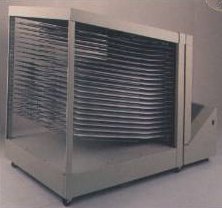 | Developed by Norfin Corporation and sold as a private lable product by Xerox, Oce' and KIP Shacoh, the Flat Sorter 36 is a good solid piece of equipment that does what it is designed to do, collate large documents very efficiently. |
| [−] |
|
Xerox Folder 36 | 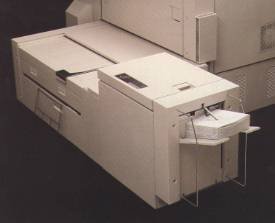 | Developed by Fuji Xerox to add "folding capacity" to the 3080, 3090 and 5080 series machines. Originally designed for folding metric size prints along the lines of European fold specifications, Xerox was never successful in converting the unit so that it would fold commonly accepted "US standard folds". |
| [−] |
|
|
|
|
405-488-7292
P.O. Box 14469 Oklahoma City, Oklahoma 73113
[email protected]
|
|
|


